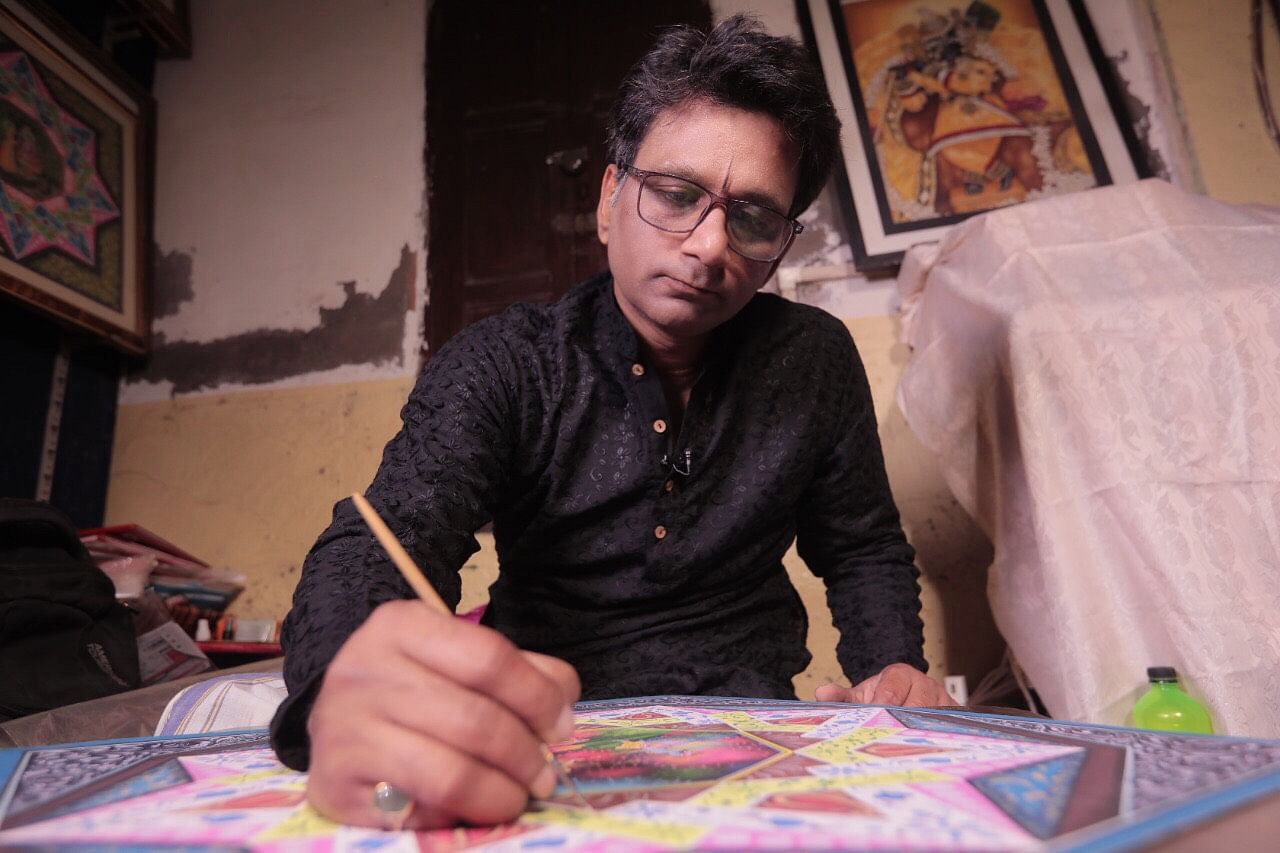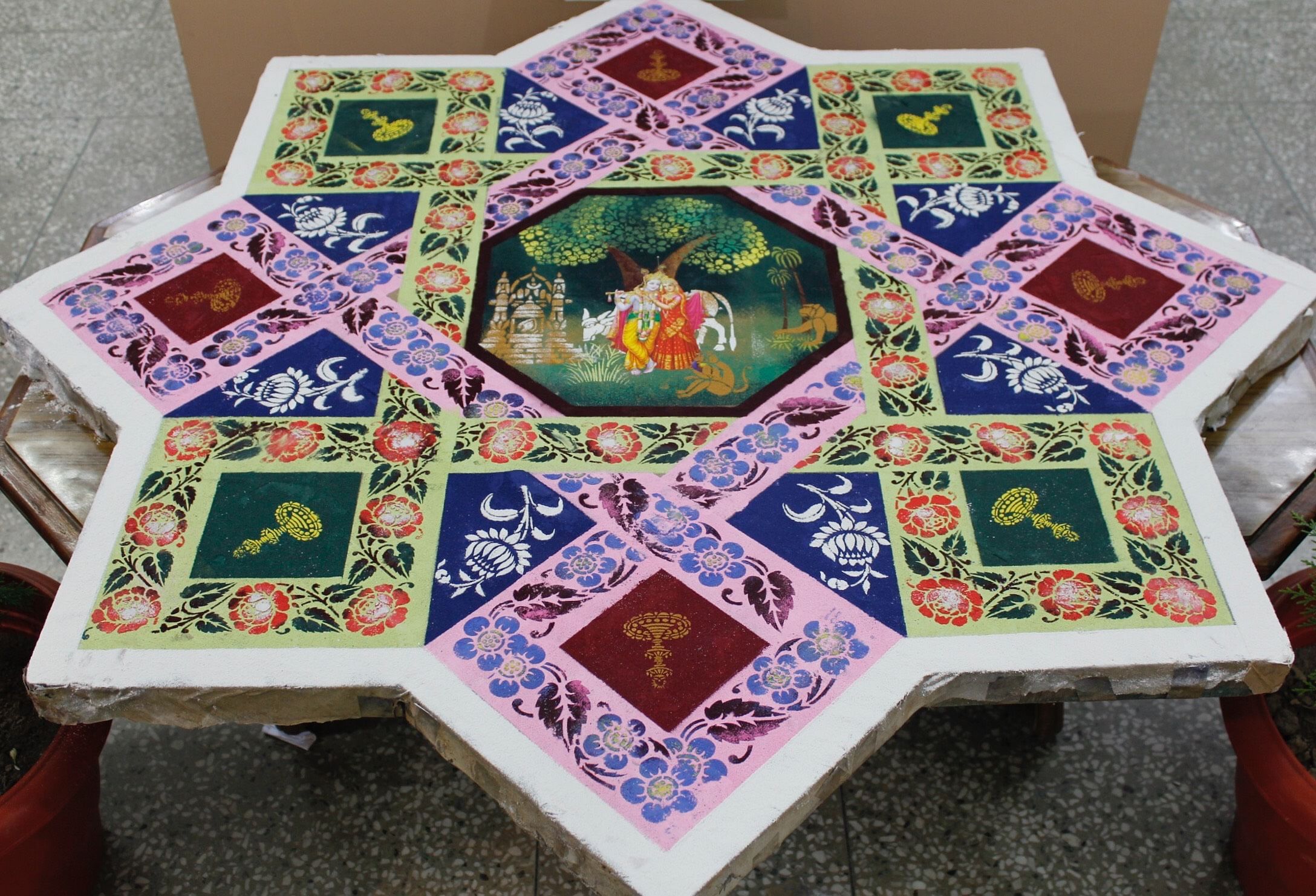

It was a moment of fame for Sanhji artists when Prime Minister Narendra Modi recently presented a Sanjhi art panel to US President Joe Biden in Tokyo. Sanjhi is an art form practised in Brindavan in Uttar Pradesh.
"Sanjhi was once extolled not just by the Bhakti poets but also by the Shiv Purana," said Vaishnavacharya Sumit Goswami, a Sanjhi artiste from Brindavan to DH. "It's good to see that it has taken its first few steps onto the international stage."
Sanjhi is usually made with the help of stencils on an "ashtkon" or a Radha Yantra, a 2" -3" high wooden or an earthen octagonal-shaped platform. Its central panel, more often than not, contains an image of Radha and Krishna. The surrounding patterns depict scenes from the celestial couple's lives, such as the raas-leela and Krishna playing the flute or tending to the cows. Decorative geometrical patterns, latticed designs and floral compositions complete the picture.
The origins of Sanjhi go back to the time of the Mahabharata. Legends have it that when Lord Krishna took his cows out for grazing, his consort Radha would spend the day waiting for his return at sunset.
She would decorate their meeting place with beautiful patterns made with coloured powder, flowers, beads, and stones to kill time. The art that Radharani (as she's referred to in Brajbhumi) created thus came to be called "Sanjhi" (named after sanjh or evening time).
Goswami says that the tradition of Sanjhi has since continued— but with a difference. Instead of making it every day, the temple priests make it once a year for 15 days during the shraddh period. In the Hindu month of Bhadon, during pitru paksha, rituals and prayers are performed for the family's departed souls.
However, despite the quiet and sombre mood of shraddh, some temples in Brindavan observe the Sanjhi Mahotsav during this period—when temple courtyards come alive with intricate, colourful floor decorations painstakingly done by the temple priests.
"To help overcome the solemn mood of shraddh, Sanjhi started being done in the temple courtyard," says the 45-year-old Goswami, who has been making Sanjhi since he was barely in his teens. "Of course, back then, we kids were allowed to try our hand on the simpler portions while our experienced elders worked on the intricate details," he said.
Just like Radha, the priests start work on Sanjhi in the morning.
"That's because Sanjhi is very time-consuming—it can take up to 10 to 12 hours to complete an artwork. Priests often work without a break to keep it ready for the evening to welcome Krishna since they believe he visits at sanjh," said Goswami.
In the evening, prayers are offered to the Sanjhi and prasad is distributed.
And then, much to everyone's surprise, all the effort put into the Sanjhi is brought to nought when it is swept away.
"A fresh Sanjhi has to be made the next morning," said Goswami matter-of-factly. "And nothing in life is permanent."
Although Sanjhi may have garnered some attention and appreciation, Goswami often worries about this dying art form. "The younger lot of priests are fast losing interest in Sanjhi. They feel it's not worth all the effort for negligible returns," he said.
During pitru paksha Goswami makes Sanjhi in his Radha Raman temple courtyard ("and even on water"), the rest of the year, he replicates it on canvas, using oil and watercolours.
"We need to bring in changes to let Sanjhi survive," said Katyayani Agarwal, an art historian who has been promoting Sanjhi for the past four years. "It needs to move from darshan (during shraddh) to pradarshan (display) during the rest of the year to bring it closer to the outside world. And, of course, to make it more permanent and keep it alive for future generations," she adds.
Besides holding exhibitions, Goswami also organizes workshops for art schools and institutions.
"Research scholars from places like Benaras and Bengaluru come to study Sanjhi. Lately, some international artists have also evinced interest in Sanjhi and taken classes online," he said.
And now, with a Sanjhi making its way to the White House, he is sure that Radharani's art will get a new lease of life.
(Delhi-based independent writer Purnima Sharma has been a journalist with the mainstream media and a broadcaster with All India Radio. She is the happiest writing about people, places, art and culture and anything that touches the heart)